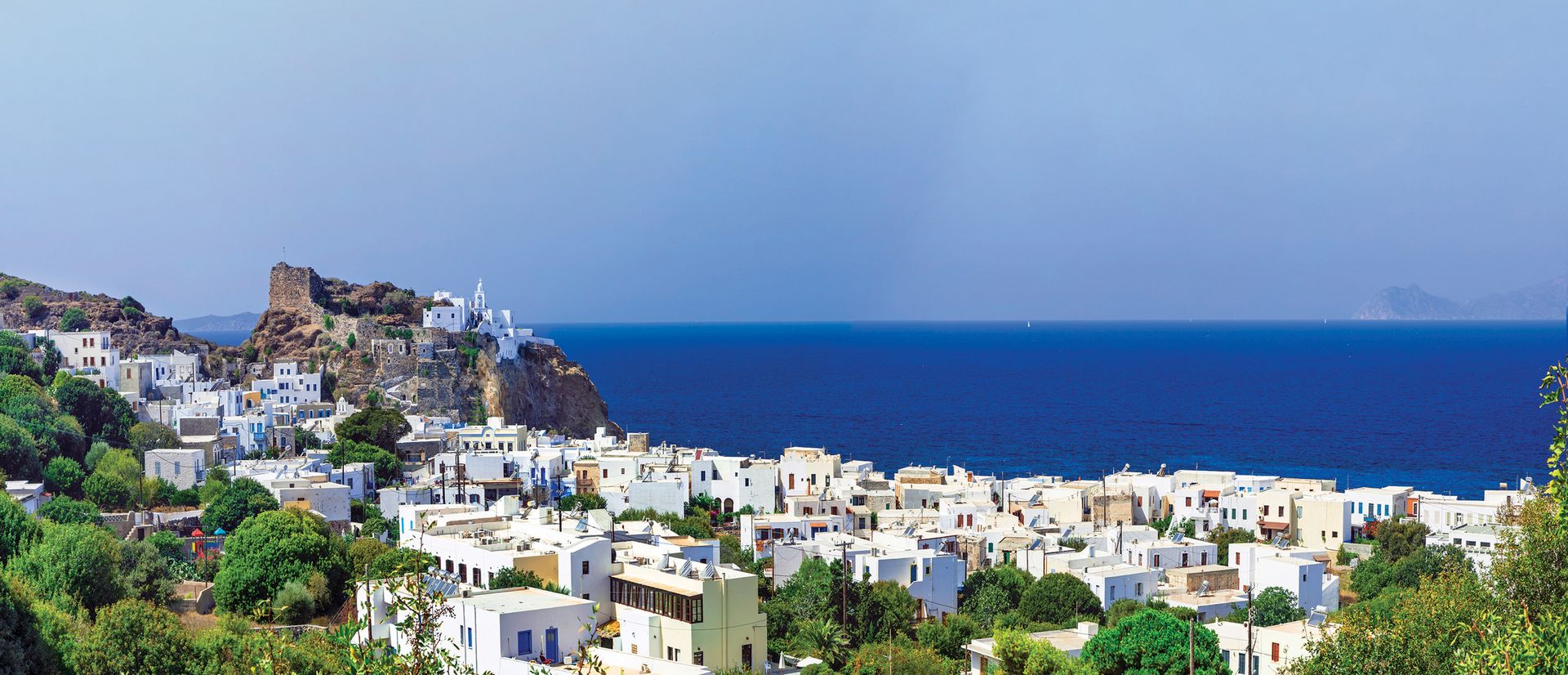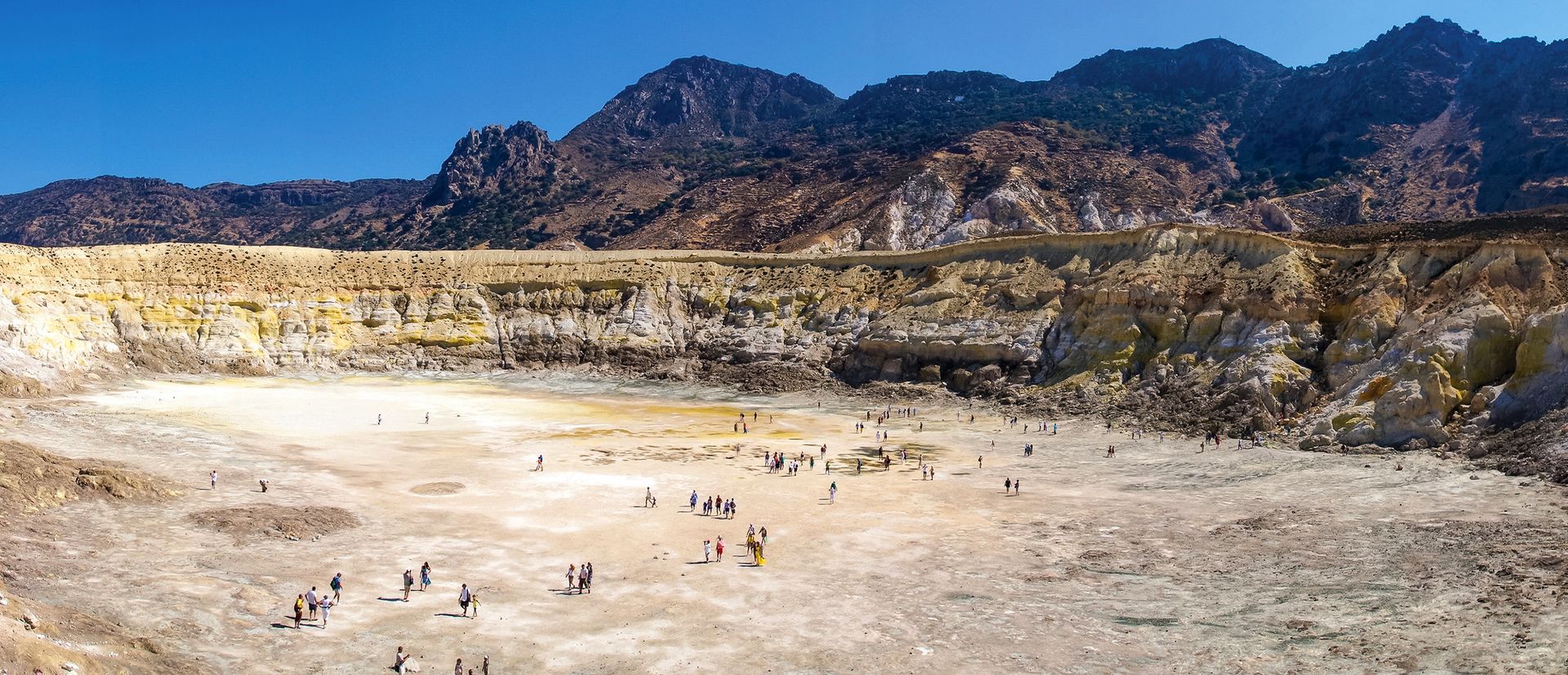Stone white, red of the volcanic rock and the black color of lava give life to the island and create a dreamy scenery, with magnificent beauty and atmosphere. The lunar scenery is excellently completed by beaches with black pebbles, black or red sand and great rocks that have been created by the volcanic origin of the island. It is the newest volcanic center of Greece. The island hosts various cultural monuments and consists of a land that has ideally combined natural beauty, historic past and cultural tradition.
A touch of Mythology
Nisyros and Kos were joined together and were divided during the Gigantomachy, the war between Gods and Giants. God Poseidon, while helping Zeus at the fight against Giants, chased after Giant Polyvotis up to Kos, he cut a part of the island and threw it to his enemy and sunk him forever to the Aegean Sea. This rock is the current island of Nisyros and the explosions of the volcano are the enraged breath and roars of the defeated Giant.
Walk in Mandraki
This small island enchants its visitors with its wild beauty, the magnificent walks at the volcanic crater and the marvellous island alleys and squares.
Take a walk to the island’s capital that you will love from the very first moment! Built amphitheatrically, at the hill on the top of which stands Paleokastro and the monastery of Panagia Spiliani, Mandraki is known for its special architecture with stone-built paths, alleys with old grocery stores, picturesque tavernas, white houses with colorful doors and endless tranquility.
In Mandraki you will meet the island’s Folklore Museum, which exhibits various folk art creations, mainly objects that locals used in the past for their daily activities (scythes, moldboars, urns etc.). There is also a great collection of embroideries, wefts, various documents as well as photographic material.
Don’t miss the square “Plateia tis Iliokiomenis” at the center of the settlement, where soumada is offered made from local mashed almond. Enjoy a unique walk in the waterfront and Chochlakous, the beach with the bright round black pebbles.
Meeting the Volcano
Time to meet Stefanos, Polyvotis and Alexandros! Meet the island’s craters from close. The caldera located at the center is 4km. long and is the gem of the geological heaven of the island. Your experience on the volcano will be unforgettable, as the yellow crystals shine in the sun, while the sulfur vapors and sulfur gases create the volcano’s characteristic smell.
After your visit to the volcano, we are certain that you would like to learn as much as possible for the volcanos of Greece and their stones!
It’s time now to visit the contemporary Volcanological Museum of the island. There you will view many geological samples, diagrams and videos and you will learn for the other Greek volcanoes, such as Methana, Milos and Santorini.
Walk in Nikia
Close to the volcano you will meet the village of Nikia which gifts a panoramic view on the crater. The square of the village is the smallest square in the world, it is named Porta and it is famous for its elliptic shape and its elaborate pebbles. On the village visitors find the impressive church of Eisodia tis Theotokou, one of the most beautiful in Greece.
Profitis Ilias
The church of Profitis Ilias is located at a tall steep formation made from red lava by an explosion of the volcano, opposite Nikia village. It is built on a mull, offering endless tranquility with panoramic view to the volcano and the Aegean blue.
Minimal with beautiful internal, the monastery of Profitis Ilias is the ideal place in Nisyros to enjoy the sunset and to feel the peacefulness offered by the blue colours combined with the beauty of the volcano.
Snorkelling in volcanic rifts
Volcanic islands usually have a rich seabed! In the seabed of Nisyros you will meet the rare phenomenon of air bubbles (due to volcano) which is accompanied by special species of fish and rich plankton. The experience of snorkelling at the volcanic rift of the island is unique!
Beaches
- Chochlakoi: the closest beach to the port, located below Panagia Spiliani. It was named after the dark, big volcanic pebbles found inside and outside the sea. At the one end of the beach there is a cave on the rocks and at the back side there are trees and bushes.
- Paloi: big beach with thin and dark sand, layered with thin pebbles and crystal clear waters. Here you can take a swim under the shade of trees. In Paloi, the tavernas of Astradeni and Afroditi serve excellent dishes.
- Pachia Ammos: beach covered with dark sand, famous for its shallow crystal clear waters and its sandy seabed. The access is particularly difficult, as the only way to approach it is through a path. This beach is offered for nudism.
- Gialiskari: small beach 2km. from Mandraki. It is a beach with dark sand and pebbles. The color of the sand used to be white in the past due to the mining of pumice stone in the area and thus it is known as “white sand”.
- Lyes: a beach with small bays, covered with oval pebbles and grey sand. There are no trees and it is not organized.
- Avlaki: one of the most distant beaches of the island. It has a small port for dives, big black pebbles and natural shade. The sea is shallow and its seabed is covered with black and red stones. It is the ideal place for relaxation, sunbathing and swimming.
Local delicacies & products
- Boukoubia (pork cooked in fat)
- Kapamas (lamb stuffed with rice)
- Pitia (zucchini blossom balls stuffed with local cheese)
- Garlic dip made from almonds
- Myzithra
- Agramythozoumo
- Xerotigana
- Diples
- Pastelaries (figs with almond and sesame)
- Foikinia (traditional dessert)
- Kanelada (drink made from cinnamon)

